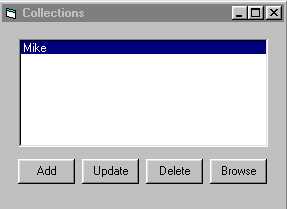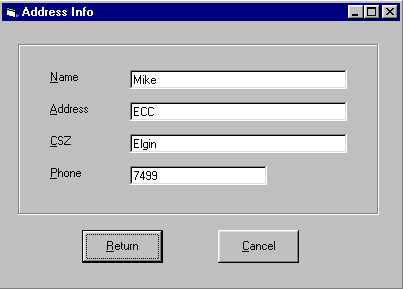

This example uses a collection class to hide the details of the Random Access processing
from the user interface. This is an enhancement to an example from last week. Note that
there is very little change to the user interface forms from the previous example. A Key
value was added to the base class of the collection. This hold the position in the Random
Access file for this item in the collection. The collection wrapper was modified to
perform updates to the file when an item is removed from the collection, or an item is
added to the collection.
The significant change to frmMain involved the record updates, but this was forced as the class item must be updated as a whole instead of each base class property individually. To leave the code alone would have triggered three updates per collection item changed.
Note the Get and Set properties for the Item method and in the Class Initialization when the Collection is populated from the content of the disk file.
The only problem that I have with this example is the coding of the file name in the class. VB does not support a parameter being passed to the Class Initialization procedure.
The User Interface, same as Week 10
 |
 |
This was the only change to the User Interface modules from last weeks example:
| Private Sub cmdUpdate_Click() If lstPerson.ListIndex = -1 Then MsgBox "Select a person to update" Exit Sub End If With frmDisplay .strMode = eUpdate BuildScreen .Show vbModal If .blnCancel = True Then Exit Sub End If ' Added to Main for Disk I/O Dim Person As New cPerson Set Person = _ m_Persons.Item(lstPerson.List(lstPerson.ListIndex)) Person.Address = .txtAddress.Text Person.CSZ = .txtCSZ.Text Person.Phone = .txtPhone.Text Set m_Persons.Item(.txtName.Text) = Person Set Person = Nothing ' m_Persons.Item(.txtName.Text).Address = .txtAddress.Text ' m_Persons.Item(.txtName.Text).CSZ = .txtCSZ.Text ' m_Persons.Item(.txtName.Text).Phone = .txtPhone.Text End With End Sub |
' Needed to update the collection item as ' a single unit instead of each base class ' property individually ' The Update is here using the Set statement ' This is from last week |
The file is opened and the collection populated when the class is initialized
| Private Sub Class_Initialize() Set mPersons = New Collection ' File contents into the Collection blnInitializing = True fnPerson = FreeFile Open GetFileName For Random _ As fnPerson Len = Len(thisPerson) ReadRecords blnInitializing = False End Sub Private Sub Class_Terminate() |
Private Sub ReadRecords() CurrentKey = 0 Get #fnPerson, , thisPerson Do Until EOF(fnPerson) With thisPerson If Not .blnDeleted Then Add .strName, _ .strAddress, _ .strCSZ, _ .strPhone Else CurrentKey = CurrentKey + 1 End If End With Get #fnPerson, , thisPerson Loop End Sub |
The Item processing had to be modified to handle a single update. Last weeks example implemented changes by updating the base class members directly. This is not practical when each update would force a write to disk.
| Public Property Set Item(ByVal strName As String,
Person As cPerson) With thisPerson .strName = Person.Name .strAddress = Person.Address .strCSZ = Person.CSZ .strPhone = Person.Phone .blnDeleted = False End With Put #fnPerson, Person.Key, thisPerson End Property |
Public Property Get Item(ByVal strName As String) As
cPerson Set Item = mPersons.Item(strName) End Property |
The Add and Remove methods were also modified to write the collection item to
disk.
The key to this example is to see how the enhancement of permanent storage for
the data had very little effect on the user interface modules. As the work is done at the
class level, any form of permanent storage could be implemented and the user interface
modules or class client does not change.